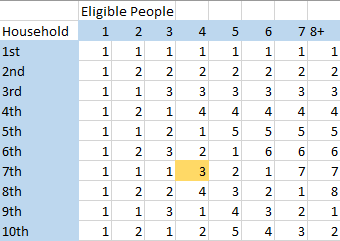A kish grid is a way of randomly choosing household survey respondents. The method avoids selection bias, which is usually a result of not using the correct procedures to choose your participants.
If you visit houses and survey the first person to answer the door, your results are probably going to be biased against the very young or very old, who are less likely to answer the door first. The Kish Grid addresses this problem by assigning numbers to each member of the household, based on age. The most important aspect of the grid is that it assigns an equal probability of selection for each possible survey participant (Lewis, Beck et. al, 2003).
Advantages over First/Last Birthday
The first birthday/last birthday method chooses participants based on which household member has the first or last birthday of the year. This method may be problematic because:
- Some countries may not celebrate birthdays.
- Not everyone in a household knows everyone else’s birthday. For example, a daughter-in-law might not know when grandpa-in-law was born, or no one may know the birth date of a new household member.
As the grid doesn’t use specific dates, these problems are avoided.
How to Use a Kish Grid
The Kish Grid has a column for each household you visit and a row for the number of eligible people. Start labeling with the youngest members of the household in order to give them a slightly greater chance of being chosen. Young people tend to be more difficult to pin down at home, so if you don’t stack the odds in their favor a little, your results might be biased in favor of older people.
To use a Kish Grid:
- Find out how many people are living in each household. Only count adults eligible for the survey, say, all those over 15.
- Assign each eligible household member a number, starting with the youngest (#1). For example, let’s say you were conducting a 10 house survey and you visited a four-person household consisting of mom, dad, a college-age son and a 90-year old grandpa, grandpa would be #4.
- Look up the column and row relevant to the household you’re visiting; For example, if this is the 7th house you’re surveying, and it is a four-person household, you’d look at column 7 row 4. If column 7 row 4 has the number 3 (as in the example grid below), survey the person you’ve labeled number 3.

Kish Grid showing which person you would survey in a four-person house that’s the 7th you’ve visited.
If the person chosen isn’t available, find out when they might be met with and try again. Dad might be at work, in which case you would have to arrange to come again after the work day was over. If the interview still doesn’t happen after 6 attempts, it should be abandoned as a casualty (Kapur, 2010).
History of the Kish Grid
The Kish Grid was first proposed by Leslie Kish in 1949. It quickly became popular and was well-used for many years. It’s become less effective because people today are less willing to give information — for example, a list of names and ages of everyone in their household— to a random telephone survey person. However, when that inhibition can be overcome, it is still a useful selection method.
Sources
Kapur, 2010. Diaspora, Development, and Democracy: The Domestic Impact of International Migration from India. Princeton University.
Kish, L. (1949). A Procedure for objective respondent selection within a household. Journal of the American Sociological Association, 44, 380-387.
Lewis-Beck, M., Bryman, A., Liao, T. (2003) The SAGE Encyclopedia of Social Science Research Methods. SAGE Publications.